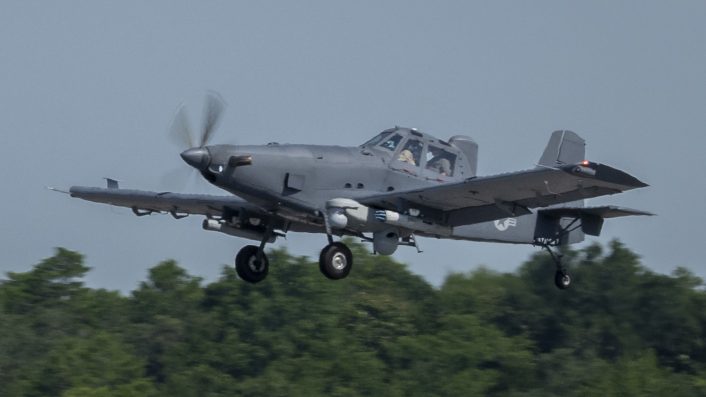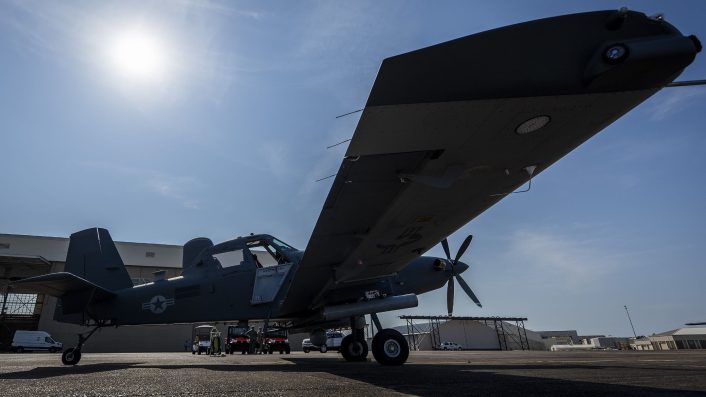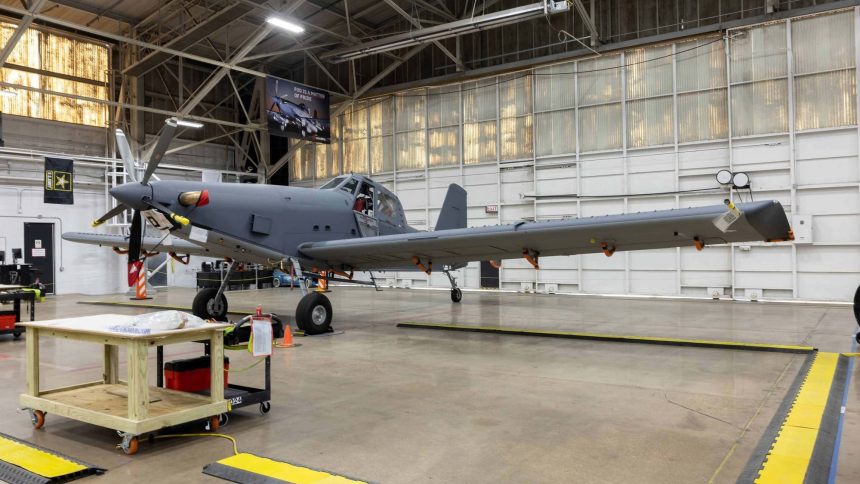While SOCOM reduces near-term OA-1K acquisitions, L3Harris boosts production in Texas, keeping the Armed Overwatch program on track for IOC in 2026.
L3Harris Technologies, manufacturer of the U.S. Special Operations Command’s (SOCOM) newest light attack and intelligence aircraft, the OA-1K Skyraider II, is expanding production to meet current and future demand, even as the aircraft faces a shifting acquisition path. In fact, while the company recently opened a new production hangar in Waco, Texas, to accelerate deliveries, SOCOM has again reduced its annual procurement, reflecting an ongoing debate over the aircraft’s long-term role.
L3Harris Expands Waco Production Hub
On Aug. 27, 2025, L3Harris announced the opening of an expanded production facility for the OA-1K Skyraider II at its Waco, Texas, site. The new hangar, outfitted with advanced manufacturing tools and streamlined processes, will serve as the central hub for the Skyraider II program.
Big milestone in Waco: Our upgraded hangar is now fully operational and building the OA-1K Skyraider II for @AFSpecOpsCmd. Read more: https://t.co/skrgsnVSc8 pic.twitter.com/howfkIXhOD
— L3Harris (@L3HarrisTech) August 27, 2025
According to the company, the site is designed to enhance production efficiency, support rapid upgrades, and accelerate aircraft testing. Aircraft inductions are already underway, with the first deliveries from the new hangar expected this fall. L3Harris also confirmed that it is delivering Skyraider II aircraft on a monthly basis to meet program requirements.
“This hangar brings together the talent and technology needed to rapidly advance the Skyraider II mission and deliver the OA-1K aircraft,” said Jason Lambert, President of Intelligence, Surveillance and Reconnaissance at L3Harris, in the company’s press release. He emphasized that the Waco facility has already supported prototype development, flight testing, and FAA certification, making it uniquely positioned to continue the program.
Texas lawmakers welcomed the expansion, highlighting both its economic and strategic implications. Congressman Pete Sessions (R-Texas) said the investment demonstrated Waco’s role as a global aerospace hub. “The innovation taking place here in Central Texas will not only revolutionize advancements on the battlefield, but also strengthen our local economy,” he noted.
The Waco site, which has more than four decades of experience in aircraft missionization, is expected to support not only U.S. Air Force Special Operations Command (AFSOC) but also allied customers who may procure the Skyraider II in the future.

SOCOM Reduces Near-Term Procurement
Despite the industrial expansion, SOCOM has once again scaled back its planned annual buys of the OA-1K. As reported by Air & Space Forces Magazine, the command intends to purchase only six aircraft in Fiscal Year 2026, down from the previously planned 12. This follows an earlier reduction in fiscal 2025, when procurement already dropped from 15 to 12 aircraft.
“OA-1K aircraft procurement has been reduced due to resource constraints,” said SOCOM spokesperson Lt. Cmdr. Kassie Collins. The command’s overall program of record, however, remains 75 aircraft.
OA-1K Skyraider II
The OA-1K Skyraider II, developed from the Air Tractor AT-802U cropduster and militarized by L3Harris under the “Sky Warden” proposal, was selected as the winner of SOCOM’s Armed Overwatch program in 2022. The aircraft is designed to conduct light attack, close air support, and intelligence, surveillance, and reconnaissance (ISR) missions. Its modular design allows crews to swap out sensors, communications suites, and payloads depending on mission requirements.
Procured by SOCOM but operated by Air Force Special Operations Command, the OA-1K is also intended to leverage resources freed up by the retirement of the U-28 Draco (a Pilatus PC-12 variant) and MC-12W Liberty (a modified Beechcraft King Air). However, SOCOM has stressed that the OA-1K is not a one-for-one replacement, but rather a flexible platform for a variety of missions.
Strategic and Budgetary Headwinds
The OA-1K acquisition cuts highlight the broader budgetary pressures facing SOCOM and the Department of Defense. Over the past two years, the Pentagon has increasingly shifted resources toward preparing for high-end conflict scenarios, particularly in the Indo-Pacific region, reducing emphasis on platforms tailored for counterinsurgency operations.
A December 2023 Government Accountability Office (GAO) report questioned whether SOCOM’s projected $2 billion Armed Overwatch program was appropriately sized for current and future requirements. The watchdog recommended a substantially smaller fleet, arguing that the command had not sufficiently analyzed how the U.S. military’s changing global posture should affect procurement.
SOCOM initially intended to acquire 75 aircraft, but its fiscal 2025 budget submission reduced the planned fleet to 62. With the new cuts for FY2026, only 45 aircraft will be on contract by 2028, and future procurement plans beyond that remain unclear.

AFSOC leadership has acknowledged these challenges. Lt. Gen. Michael Conley, commander of AFSOC, told lawmakers in early 2025 that, while demand for Air Commandos continues to exceed levels seen during the height of the Global War on Terror, maintaining technological relevance remains difficult.
“My concern is that by the time we get a fleet of 50 aircraft of any flavor updated to where they need to be, the technology’s already irrelevant,” Conley said in testimony before the House Armed Services Committee. He noted that while new tactics and training can mitigate some limitations, modernization remains critical.
Balancing Global Missions
Despite the procurement slowdown, AFSOC leaders argue that the OA-1K remains an essential capability for missions outside the Indo-Pacific. Conley emphasized that while the Indo-Pacific theater is a major priority, AFSOC must also maintain the ability to operate globally.
“We get it. But we’ve also got the rest-of-the-world mission that I’m responsible for, as well, and I want to have all the cards I can play to fight wherever they need us to,” he said in 2024.
Conley also argued that the command is already stretched thin, referring to the surge in the demand for Air Commandos. “We commit almost 100 percent of our forces in each deployment cycle,” he said. “There’s no excess left.”
For now, the OA-1K remains on track to achieve IOC within the planned timeline, with government verification testing, operator training, and tactics development underway. SOCOM officials maintain that the aircraft will provide AFSOC with a versatile, cost-effective tool for a variety of mission sets, even as procurement rates fluctuate.










